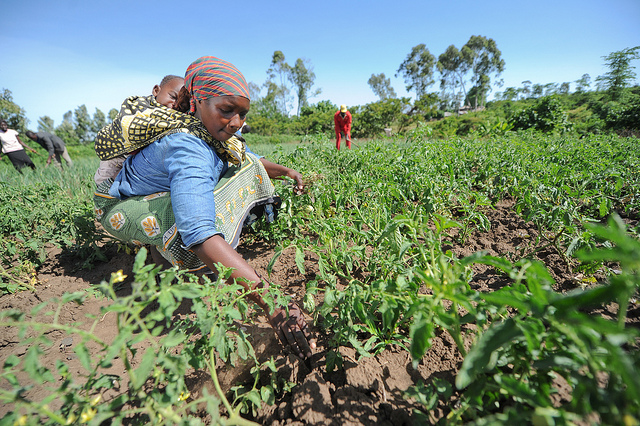By: Roger Williamson
Send to a friend
The details you provide on this page will not be used to send unsolicited email, and will not be sold to a 3rd party. See privacy policy.
It will be even harder to feed the world in 2050, but African farmers could be key, says Roger Williamson.
An alarming study has found that major crop yields are increasing too slowly to meet future food demands. With the latest UN projections suggesting a world population of 9.6 billion by 2050 [1] and the population rising by more than 80 million a year — with the fastest rates in some of the most populous African countries — how will the human race feed itself?
In future, will we be talking about three to four billion people in extreme poverty rather than the current 'bottom billion'?
A recent, timely book, 10 Billion by Stephen Emmott [2], paints a bleak picture. Emmott examines technological fixes or changes in behaviour or political will as potential solutions, but says these are likely to fail.
This conclusion must be taken seriously. A key part of his narrative is that there is simply not enough land to feed the growing population — more importantly, one with growing food needs. What's left are cities, where you buy food (not grow it); oceans, which are largely being overfished; forests; and desert. Thus there are only two real possibilities: somehow finding more land to cultivate or improving yields from existing cropland.
A video posted online earlier this month by the ReCom programme — which aims to research and communicate what works in foreign aid — of the UN University-World Institute for Development Economics Research (UNU-WIDER), based in Finland, provides a more hopeful scenario for Africa.
In it, Ephraim Nkonya, a Tanzanian land management specialist at the International Food Policy Research Institute, makes the surprising statement that Africa could become the world's breadbasket.
His argument hinges around two interlinked opportunities — that the yield gap for current and maximum potential production for crops is greatest in Sub-Saharan Africa, and that there is potential for radically expanding food production through increasing the area of land under production. According to Nkonya, 90 per cent of all land that could be brought under cultivation is in Africa or Latin America.
Akio Hosono, of the Japan International Cooperation Agency (JICA) Research Institute, recently presented positive examples of the latter at a UNU-WIDER conference. He highlighted the use of Brazil's vast Cerrado region for soya production. [3] JICA and the Brazilians are exploring this model's applicability to Mozambique. [4]
However, increasing crop yields by expanding the area under cultivation often means deforestation. Intensification of yield is the key.
Forecasts of having three to four billion people living in absolute poverty, and strategies for eradicating this problem, are questions for science, but they are also more than that. Social and economic issues of extreme inequality (for example around access to land) and consumption patterns (for example ensuring that resources for food production are distributed equally) are also vital elements to the mix.
Roger Williamson is an independent consultant and visiting fellow at the Institute of Development Studies at the University of Sussex, United Kingdom. Previous positions include organising nearly 80 international policy conferences for the UK Foreign Office and being head of policy and campaigns at Christian Aid.
References
[1] Worldwatch Institute Fertility Surprises Portend a More Populous Future (Worldwatch Institute, 10 July 2013)
[2] Emmott, S. 10 Billion (Penguin, 2013)
[3] Hosono, A. Industrial Strategy and Economic Transformation (ReCom, accessed 26 July 2013)
[4] Hosono, A. South-South/Triangular Cooperation and Capacity Development. In K. Hiroshi (ed) Scaling Up South-South and Triangular Cooperation (JICA Research Institute, November 2012)














